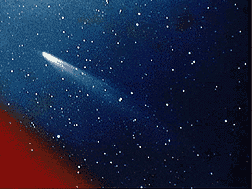
Photo of Comet Kohoutek taken by members of the lunar
and
planetary laboratory photographic team from the University
of Arizona, at the Catalina observatory, Jan. 11, 1974.

Photo of Comet Kohoutek taken by members of the lunar
and
planetary laboratory photographic team from the University
of Arizona, at the Catalina observatory, Jan. 11, 1974.
Comets are chunks of matter that orbit the sun in highly eccentric (non-circular) orbits. When they get near the sun, some of the comet matter melts and vaporizes and the result is the long tail we associate with the comet shape; however, during most of their orbit, they have no tail. Since their orbits are so elliptical, most spend a majority of their time well outside the orbit of Pluto. Often called "dirty snowballs," they are made of rock and ice (frozen water and other frozen gasses). Comets leave behind a trail of dust as they travel, and whenever the earth passes through this trail, we have a meteor shower. These meteor showers occur on a regular basis as we orbit the sun, and they are named for the constellation from which they seem to originate. For instance, comet Halley is responsible for the dust and pebbles that give us the Orionid meteor shower each October.
©2001 Jeff Goodman